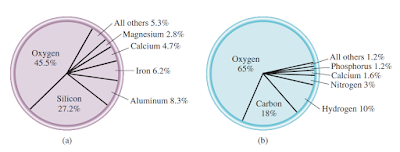The
majority of elements are naturally occurring. How are these elements
distributed on Earth, and which are essential to living systems?
Earth’s
crust extends from the surface to a depth of about 40 km (about 25 mi). Because
of technical difficulties, scientists have not been able to study the inner
portions of Earth as easily as the crust. Nevertheless, it is believed that
there is a solid core consisting mostly of iron at the center of Earth.
Surrounding the core is a layer called the mantle, which consists of hot
fluid containing iron, carbon, silicon, and sulfur.
Of the 83
elements that are found in nature, 12 make up 99.7 percent of Earth’s crust by
mass. They are, in decreasing order of natural abundance, oxygen (O), silicon
(Si), aluminum (Al), iron (Fe), calcium (Ca), magnesium (Mg), sodium (Na),
potassium (K), titanium (Ti), hydrogen (H), phosphorus (P), and manganese (Mn).
In discussing the natural abundance of the elements, we should keep in mind that (1) the
elements are not evenly distributed throughout Earth’s crust, and (2) most
elements occur in combined forms. These facts provide the basis for most
methods of obtaining pure elements from their compounds, as we will see in
later chapters.
The accompanying table lists the essential
elements in the human body. Of special interest are the trace elements, such
as iron (Fe), copper (Cu), zinc (Zn), iodine (I), and cobalt (Co), which
together make up about 0.1 percent of the body’s mass. These elements are
necessary for biological functions such as growth, transport of oxygen for
metabolism, and defense against disease. There is a delicate balance in the
amounts of these elements in our bodies. Too much or too little over an
extended period of time can lead to serious illness, retardation, or even
death. |
| Structure of Earth’s interior. |


No comments:
Post a Comment